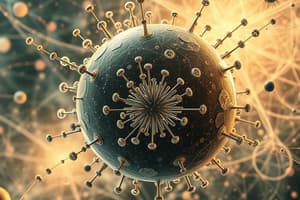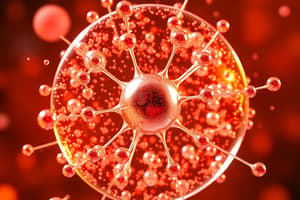Podcast
Questions and Answers
What are the three main states of matter?
What are the three main states of matter?
- Solid, gas, Bose-Einstein condensate
- Solid, liquid, gas (correct)
- Solid, liquid, plasma
- Liquid, gas, plasma
What is the physical change of a solid into a liquid by the addition of energy as heat?
What is the physical change of a solid into a liquid by the addition of energy as heat?
- Freezing
- Condensation
- Sublimation
- Melting (correct)
What are the four states of matter, including plasma?
What are the four states of matter, including plasma?
- Solid, liquid, gas, plasma (correct)
- Liquid, gas, plasma, Bose-Einstein condensate
- Solid, liquid, gas, Bose-Einstein condensate
- Solid, gas, plasma, Bose-Einstein condensate
Which of the following is NOT a physical property of matter?
Which of the following is NOT a physical property of matter?
What is the name given to the state of matter in which separate atoms or subatomic particles are cooled to near absolute zero?
What is the name given to the state of matter in which separate atoms or subatomic particles are cooled to near absolute zero?
A physical change alters the composition of a substance.
A physical change alters the composition of a substance.
A chemical change involves a change in the chemical composition of a substance.
A chemical change involves a change in the chemical composition of a substance.
What are the main evidences of a chemical change?
What are the main evidences of a chemical change?
Describe the difference between a physical change and a chemical change.
Describe the difference between a physical change and a chemical change.
Match the following changes in state of matter with their descriptions:
Match the following changes in state of matter with their descriptions:
The particles in a solid are widely separated and move freely.
The particles in a solid are widely separated and move freely.
The particles in a liquid are loosely packed and can move around.
The particles in a liquid are loosely packed and can move around.
The particles in plasma are charged and move freely.
The particles in plasma are charged and move freely.
Plasma is considered the rarest state of matter naturally found on Earth.
Plasma is considered the rarest state of matter naturally found on Earth.
Bose-Einstein condensate is a state of matter that is extremely hot.
Bose-Einstein condensate is a state of matter that is extremely hot.
A physical property can be observed without changing the composition of a substance.
A physical property can be observed without changing the composition of a substance.
Which of the following is NOT a chemical property?
Which of the following is NOT a chemical property?
A chemical change is always irreversible.
A chemical change is always irreversible.
Give three examples of physical changes.
Give three examples of physical changes.
Flashcards
Solid
Solid
A state of matter characterized by a definite shape and volume. The particles are tightly packed and arranged in a regular pattern.
Liquid
Liquid
A state of matter characterized by a definite volume but an indefinite shape. The particles are loosely packed and can move past each other.
Gas
Gas
A state of matter characterized by an indefinite shape and volume. The particles are widely separated and move freely.
Plasma
Plasma
Signup and view all the flashcards
Particle Theory of Matter
Particle Theory of Matter
Signup and view all the flashcards
Temperature
Temperature
Signup and view all the flashcards
Volume
Volume
Signup and view all the flashcards
Density
Density
Signup and view all the flashcards
Incompressibility
Incompressibility
Signup and view all the flashcards
Fluidity
Fluidity
Signup and view all the flashcards
Diffusibility
Diffusibility
Signup and view all the flashcards
Compressibility
Compressibility
Signup and view all the flashcards
Bose-Einstein Condensate
Bose-Einstein Condensate
Signup and view all the flashcards
Freezing Point
Freezing Point
Signup and view all the flashcards
Melting Point
Melting Point
Signup and view all the flashcards
Boiling Point
Boiling Point
Signup and view all the flashcards
Condensation Point
Condensation Point
Signup and view all the flashcards
Freezing
Freezing
Signup and view all the flashcards
Melting
Melting
Signup and view all the flashcards
Boiling
Boiling
Signup and view all the flashcards
Condensation
Condensation
Signup and view all the flashcards
Sublimation
Sublimation
Signup and view all the flashcards
Deposition
Deposition
Signup and view all the flashcards
Heat of Fusion
Heat of Fusion
Signup and view all the flashcards
Heat of Vaporization
Heat of Vaporization
Signup and view all the flashcards
Study Notes
States of Matter
- Matter exists in five states: solid, liquid, gas, plasma, and Bose-Einstein condensate
- Matter is anything that has mass and occupies space. It can be living or non-living.
- Matter can be detected using the senses. It makes up everything in the world.
- Scientists now study four states, including plasma and Bose-Einstein condensate, in addition to the familiar three.
Particle Theory of Matter
- Matter is made of tiny particles.
- These particles are in constant motion and are held together by attractive forces.
- The movement of these particles (and the amount of space between them) depends on the amount of energy they possess.
Solid State
- Solids have a definite shape and volume.
- Particles in solids are tightly packed and arranged in a regular pattern.
- This tight arrangement makes solids incompressible.
- Solids have the lowest kinetic energy.
- Solids contain more matter per unit volume, yielding high density.
- Examples include a cup, shirt, book, eraser.
Liquid State
- Liquids have a definite volume, but they take the shape of their container.
- Particles in liquids are loosely packed and can move and slide past each other.
- Liquids can assume the shape of their container.
- Liquid particles have higher kinetic energy than those in solids.
- Examples include maple syrup, shampoo, olive oil, orange juice.
Gaseous State
- Gases have no definite volume and take the shape of their container.
- Particles in a gas are widely separated.
- Gas particles have the highest kinetic energy.
- Gases readily fill all available space.
- Gases are compressible.
- Examples include helium in a balloon, steam from a kettle, argon in a tank, nitrogen in a tank.
Plasma State
- Plasma has no definite volume or shape.
- Plasma contains charged particles that are widely separated.
Bose-Einstein Condensate
- A Bose-Einstein condensate is a state of matter where separate atoms or subatomic particles, cooled to near absolute zero, coalesce.
- These particles act as if they were one single atom, on a macroscopic scale.
- Examples include lasers, neutron stars, and quantum computers.
Changes in Matter
- Matter can change from one phase to another when conditions change, mostly temperature.
- Rising temperature increases particle kinetic energy, causing matter to change state into more active ones.
- Lowering temperatures decreases the energy of the particles, leading to them being attracted to each other, potentially changing states.
Physical Changes
- In physical changes, the substance's composition is not altered.
- Common physical changes include transitions between solid, liquid, and gas (e.g., melting, freezing, evaporation, condensation, sublimation, deposition).
Chemical Changes
- In chemical changes, the chemical composition of the substance is altered, resulting in a new substance.
- Examples include rotting fruit, cooking an egg, burning wood, rusting metal, and baking a cake.
- Evidences of a chemical change include a change in colour, odor, or taste, and/or the release of gas.
Studying That Suits You
Use AI to generate personalized quizzes and flashcards to suit your learning preferences.




